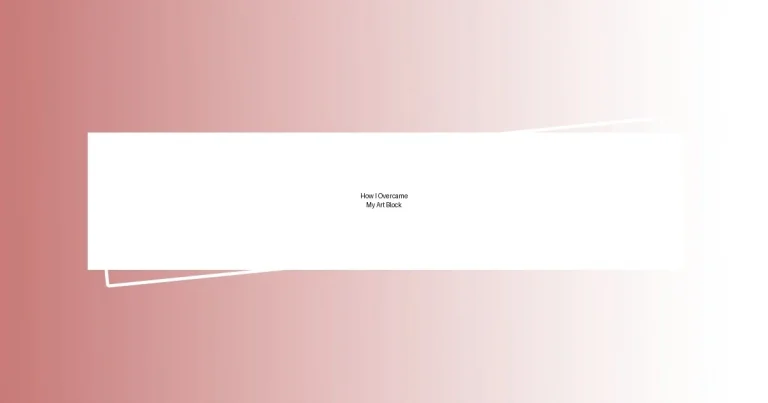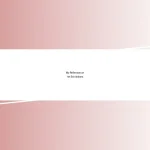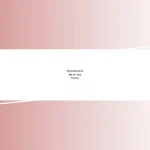Key takeaways:
- Art block can arise from internal pressures, emotional states, and external comparisons, impacting creativity.
- Acknowledging and processing emotions, such as frustration and sadness, can enhance artistic expression and help overcome creative blocks.
- Setting small, achievable goals and establishing a consistent routine can reignite creativity and foster a positive artistic mindset.
- Exploring new mediums and reflecting on past progress can provide inspiration and a sense of accomplishment in the creative journey.
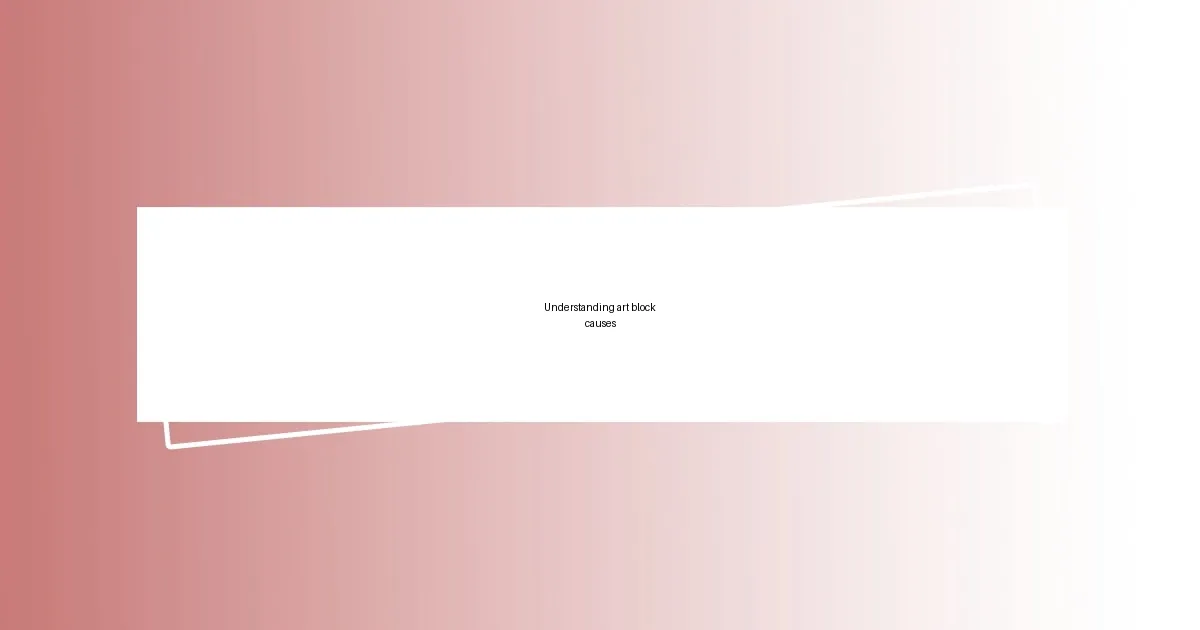
Understanding art block causes
Art block can stem from various sources, each unique to the individual artist. For me, it often felt like a heavy weight on my shoulders whenever I was faced with the pressure of perfection. I’d ask myself, “Why can’t I just enjoy the process?” This inner dialogue revealed a fear of judgment that stifled my creativity.
Over time, I’ve realized that external factors like stress or life changes play significant roles in triggering art block. I remember a particularly challenging period when a family member fell ill. The emotional turmoil I faced drained my energy and focus, making it nearly impossible to pick up a brush. It’s almost as if our emotional states can directly influence our artistic flow, wouldn’t you agree?
There’s also the ever-persistent comparison trap lurking around artist communities. I’ve found myself scrolling through social media, feeling inadequate while seeing others’ seemingly effortless creations. Have you ever felt that pang of envy that kept you from creating? I learned that recognizing these comparison cycles can help break the chain of negativity and pave the way toward reclaiming my creative joy.
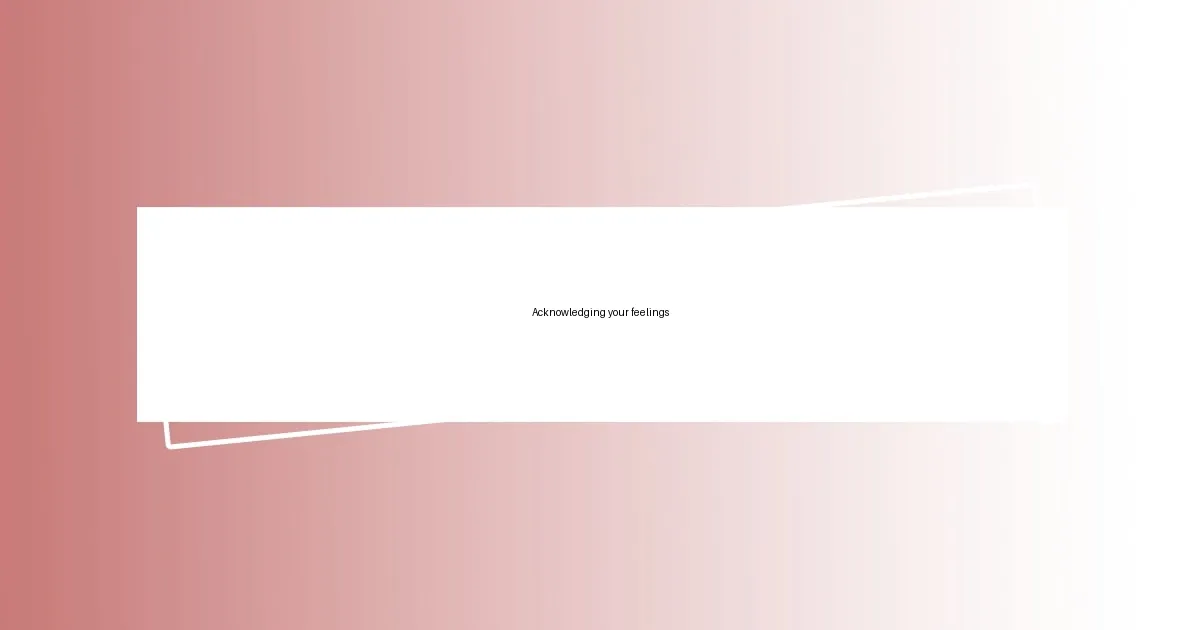
Acknowledging your feelings
Acknowledging our feelings is a crucial step toward overcoming any kind of creative block. I remember the time I simply couldn’t paint. At first, I felt guilt wash over me, convinced I was letting my passion slip away. But eventually, I learned that it was okay to sit with those feelings of frustration and disappointment. Recognizing them helped me understand my emotional landscape better, allowing me to approach my art with a renewed, honest perspective.
I’ve also experienced moments where my emotions seemed all-consuming. There was this one time when I was overwhelmed by personal issues and felt completely detached from my creative self. Instead of pushing through, I allowed myself to document my feelings in a journal. Writing it out gave me clarity and helped me process the emotional baggage, which ultimately reignited my desire to create again. Have you ever found that expressing your feelings in a different form can enhance your creative output?
It’s fascinating how acknowledging our emotions can open up new avenues for expression. I started to explore how sadness, joy, or even anxiety could blend into my artwork. For example, I experimented with darker colors during a tough time, channeling my emotions into brush strokes that reflected my inner turmoil. This exploration helped me embrace my feelings as an integral part of my artistic identity rather than a barrier.
| Emotion | Effect on Creativity |
|---|---|
| Frustration | Leads to guilt; initial block in creativity |
| Overwhelm | Can cause disconnection; journaling helps process |
| Sadness | Can inspire deeper connections in artwork |
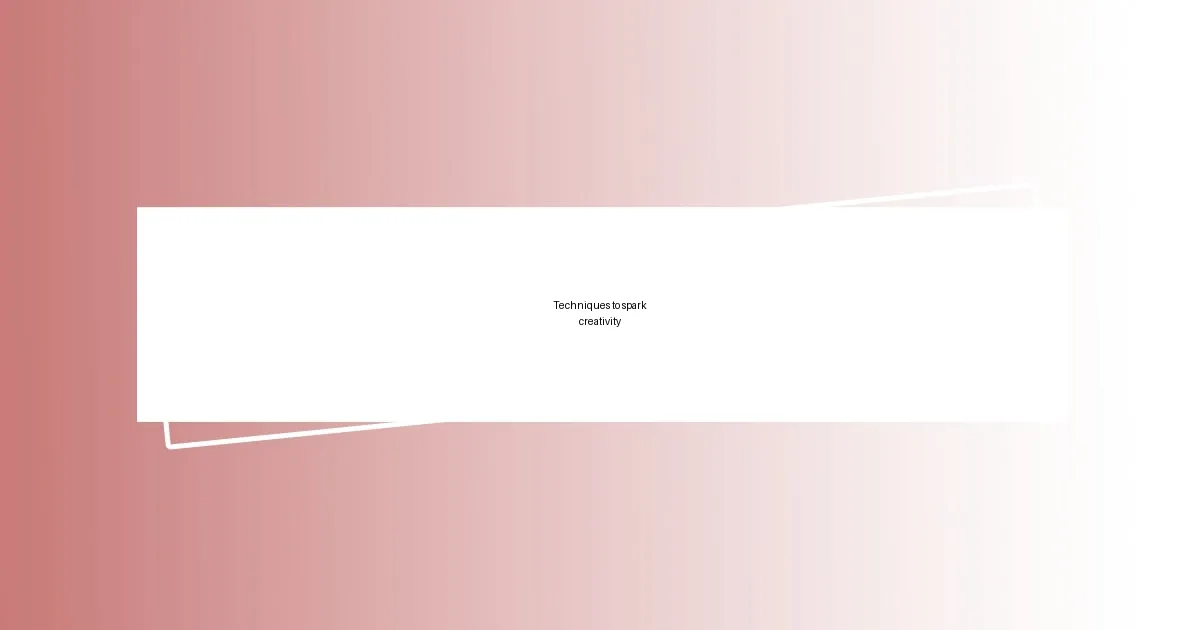
Techniques to spark creativity
Finding ways to ignite creativity can sometimes feel like searching for a spark in the dark. I recall a weekend when I felt completely uninspired, so I decided to shake things up by changing my environment. I went to a local café, brought my sketchbook, and allowed myself to soak in the buzz of conversations and the aroma of coffee. That change in scenery worked wonders; I sketched a bustling street scene and felt the creative energy flowing back. It’s surprising how a simple shift can awaken our imagination.
Here are some techniques that have helped me reignite my creative fire:
- Change Your Environment: Whether it’s a café, park, or a different room, a new setting can stimulate fresh ideas.
- Practice Freewriting or Doodling: Set a timer and let your thoughts flow onto paper without judgment. You might uncover unexpected ideas.
- Engage with Other Art Forms: Watching a movie or listening to music can inspire your work unexpectedly; I once painted a series based on songs that moved me.
- Take Breaks with Purpose: Allow yourself guilt-free time to step away from your art. I find going for a walk or indulging in a hobby revives my energy and perspective.
- Set Small, Achievable Goals: Instead of aiming for a masterpiece, I focus on simply creating for 10 minutes. This often leads to longer sessions.
By experimenting with these techniques, I’ve managed to overcome creative hurdles that once felt insurmountable, transforming moments of stagnation into bursts of inspiration.
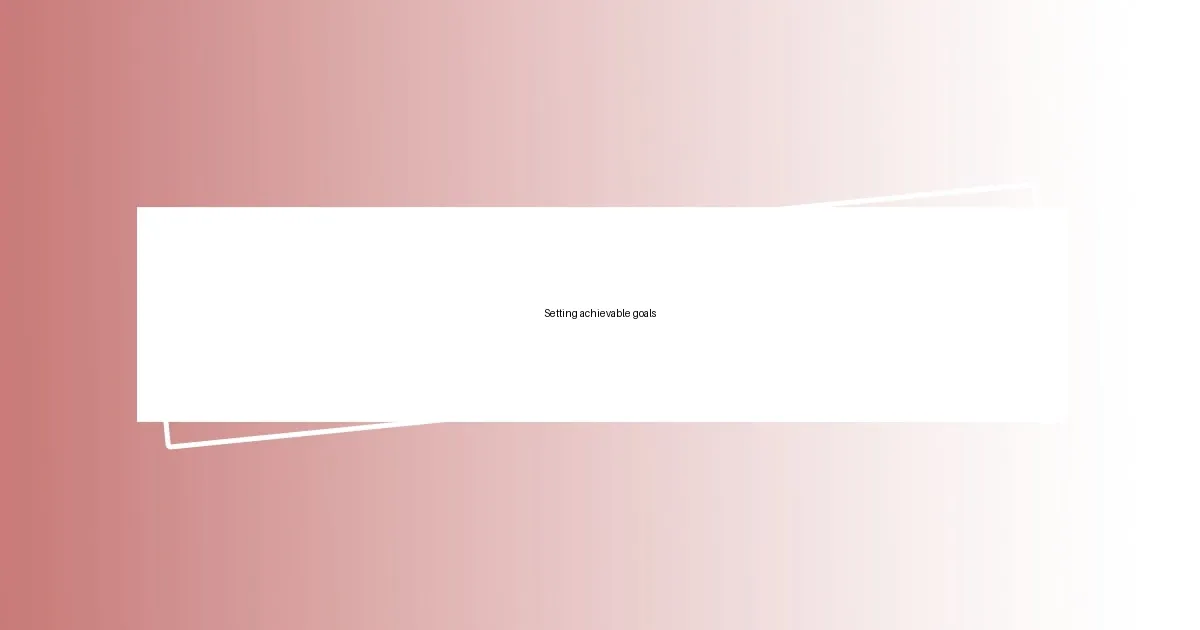
Setting achievable goals
Setting achievable goals has been a game changer for my creative process. I remember a phase when I set myself grand expectations, like completing a full painting each week. It felt overwhelming and often led to self-doubt. Instead, I shifted my focus to smaller tasks, like dedicating just 15 minutes a day to sketching. This shift made the process feel lighter and opened the door for spontaneity in my art.
Have you ever found it difficult to start because the goal seemed too big? I often remind myself to celebrate those tiny victories. For instance, instead of fixating on the end product, I focused on just playing with colors one day. This simple act allowed me to immerse myself in the joy of creation and gradually rekindle my passion without the pressure of perfection hanging over me. The shift in mentality transformed my approach, revealing how liberating it can be to lessen the stakes.
Truly, each small accomplishment builds momentum. When I completed a minimal sketch, it felt like a triumph, even if it was just a doodle. This series of achievable goals kept my creative spirit alive, gradually leading me back to bigger projects. Isn’t it fascinating how a small step can lead to an unexpected leap in creativity? By reframing my goals to be more attainable, I found the joy in the journey, and I encourage you to explore how setting smaller, manageable goals can reignite your artistic flame.
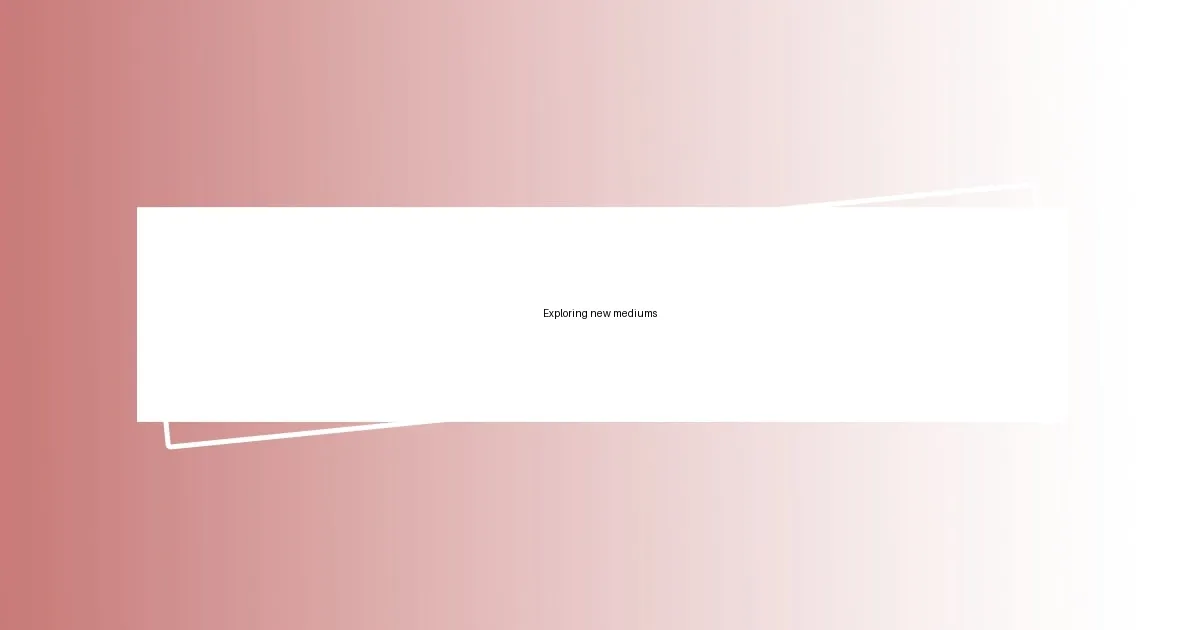
Exploring new mediums
Exploring new mediums has been a transformative experience for me. I clearly remember the day I picked up watercolor paints for the first time. I was skeptical at first, worried that I wouldn’t know how to control the flow of colors. However, as I splashed hues onto paper, I discovered a newfound freedom. The unpredictability of watercolors allowed me to let go of my perfectionist tendencies, resulting in delightful serendipity. Who knew that a simple brushstroke could evoke such joy and creativity?
Recently, I tried my hand at digital art, and it was like stepping into a whole new dimension. The versatility of tools and effects opened my eyes to possibilities I hadn’t considered before. The thrill of experimenting with layers and textures ignited my passion further. Have you ever felt that electricity in your fingertips when creating something entirely fresh? Embracing new mediums has not only expanded my artistic repertoire but also reconnected me with the excitement I experienced when I first started making art.
There’s something incredibly liberating about challenging yourself with unfamiliar materials. I recall experimenting with clay and discovering the joy of molding and shaping with my hands. It reminded me that art doesn’t have to fit within societal confines or expectations. Playfulness returned to my practice and ignited a sense of childlike wonder. Are there mediums you’ve been curious about? I encourage you to just dive in. Trust in the process, and you might just find your next spark.
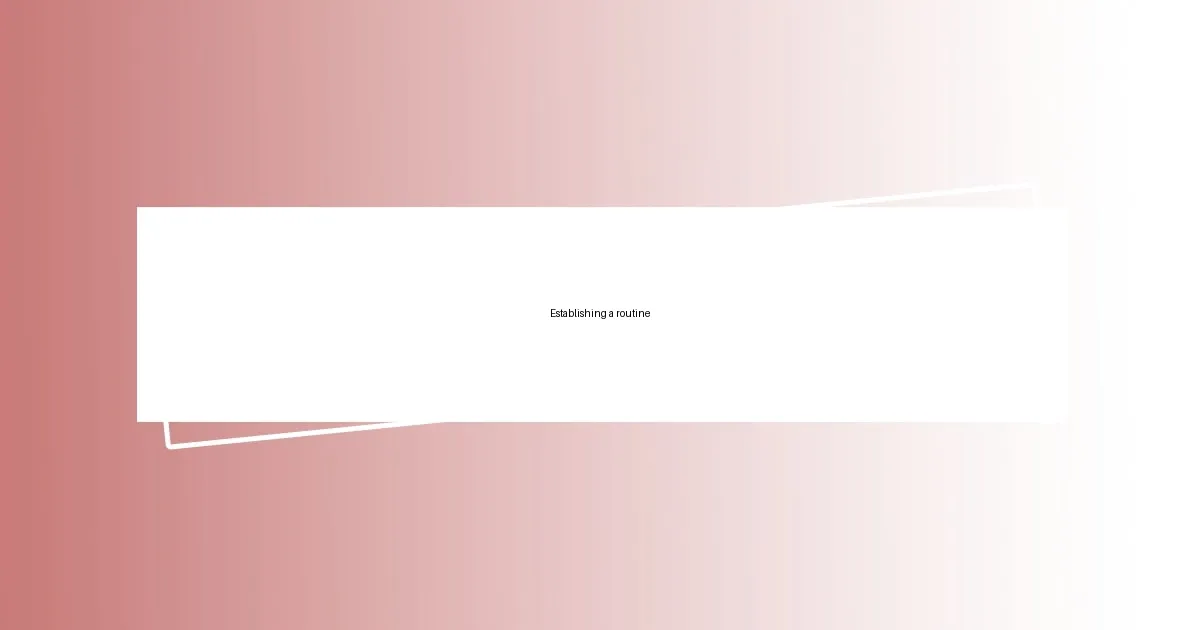
Establishing a routine
Establishing a routine may sound mundane, but it can be an absolute game changer for overcoming art block. I remember when I decided to carve out time every morning, just before breakfast, to spend half an hour creating. The quiet of those early hours became my haven, where I could lose myself in my sketches without distractions. It was amazing how quickly that consistency transformed my mindset, making art feel like a natural part of my morning – like a cup of coffee for my creativity.
In those moments, I learned the importance of treating art like a commitment. When friends would ask if I wanted to hang out in the early hours, I couldn’t help but smile and say, “Sorry, I have a date with my sketchbook.” Adopting that playful attitude helped me view my routine not as a chore, but as a special pact with myself. Doesn’t it feel empowering to prioritize your creative passion? I truly began to anticipate those early morning sessions as a reward rather than an obligation, fueling my excitement for the day ahead.
Over time, I noticed that sticking to my routine didn’t just boost my creativity; it instilled a sense of discipline. I began to incorporate mini-challenges into my sessions, such as experimenting with different styles or themes each week. There was one week where I focused solely on self-portraits; it sparked deep reflection and even some laughter, as I realized how expressive I could be with simple lines. Have you ever tried setting little challenges within your routine? I encourage you to find what works for you — that rhythm just might be the heartbeat your creativity has been searching for.
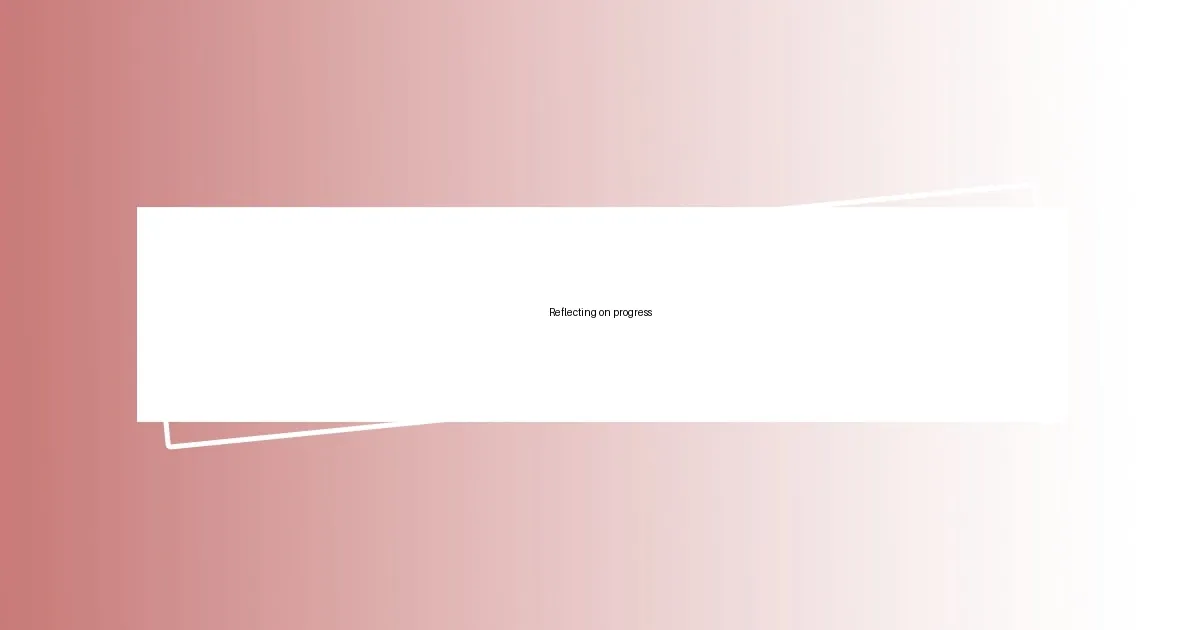
Reflecting on progress
Reflecting on my progress has been a critical part of overcoming my art block. After revisiting older pieces, I often find myself surprised at how far I’ve come. I used to face a blank canvas with trepidation, but now, I see each attempt as a stepping stone. Does that resonate with you? There’s something liberating about acknowledging those past struggles and realizing they shaped my current skills and confidence.
One of my favorite memories comes from a particularly challenging piece I created last year. It started as a chaotic mix of colors and lines that felt like a mess at first. But as I spent time with it, allowing my emotions to guide the brush, that “mess” slowly morphed into something beautiful. Looking back, I can smile at the evolution that took place. How often do we forget to appreciate our creative journeys? I’ve learned that every artwork tells a story, and taking a moment to reflect helps unveil that narrative.
As I evaluate my progress, I also celebrate those small victories, like the day I finally mastered shading techniques that once eluded me. Finding joy in these milestones keeps my motivation alive. Have you ever celebrated a minor achievement in your art journey? I encourage you to mark those moments as they build your creative resilience. Reflecting on where I started and where I am now fills me with gratitude and fuels my desire to continue growing.












